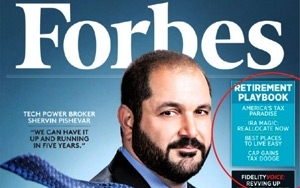
The march of native advertising continued this week, as
Forbes dispensed with another traditional taboo. It put a native ad on the cover of its print edition for the March 2, 2015
issue, due out on newsstands on Monday.
The ad for Fidelity Investments calls out the FidelityVoice branded content inside the magazine; FidelityVoice is a regular feature in
Forbes’ print and online publications, appearing as part of Forbes’ BrandVoice native ad offerings.
The cover ad pointing readers to the FidelityVoice content is a small
black box on the right side of the cover, including the FidelityVoice header and a tagline that reads: “Revving Up Your Retirement.”
The ad appears below cover teasers for regular
editorial content about retirement planning, appearing in a light blue box. The ad placement is contextually relevant but also easily distinguishable from editorial content. However, it does not carry
an explicit disclaimer identifying it, for example, as “sponsored content.”
advertisement
advertisement
Magazine publishers have been flirting with putting ads on covers for a while, generally by placing ads
on fake covers, cover flaps or wraps.
Last May, Time Inc. placed small ads for Verizon on the covers of Time and Sports Illustrated magazines, located near the
magazines’ mailing labels or barcodes. Like the Forbes native cover ad, the Verizon message referred readers to additional content inside the magazine.
While they may be
unobtrusive, these ads would appear to depart from the American Society of Magazine Editors’ editorial guidelines, including the unambiguous directive “Don’t Print Ads on
Covers.”
The ASME guidelines further clarify: “The cover is the editor and publisher’s brand statement. Advertisements should not be printed directly on the cover or
spine.”